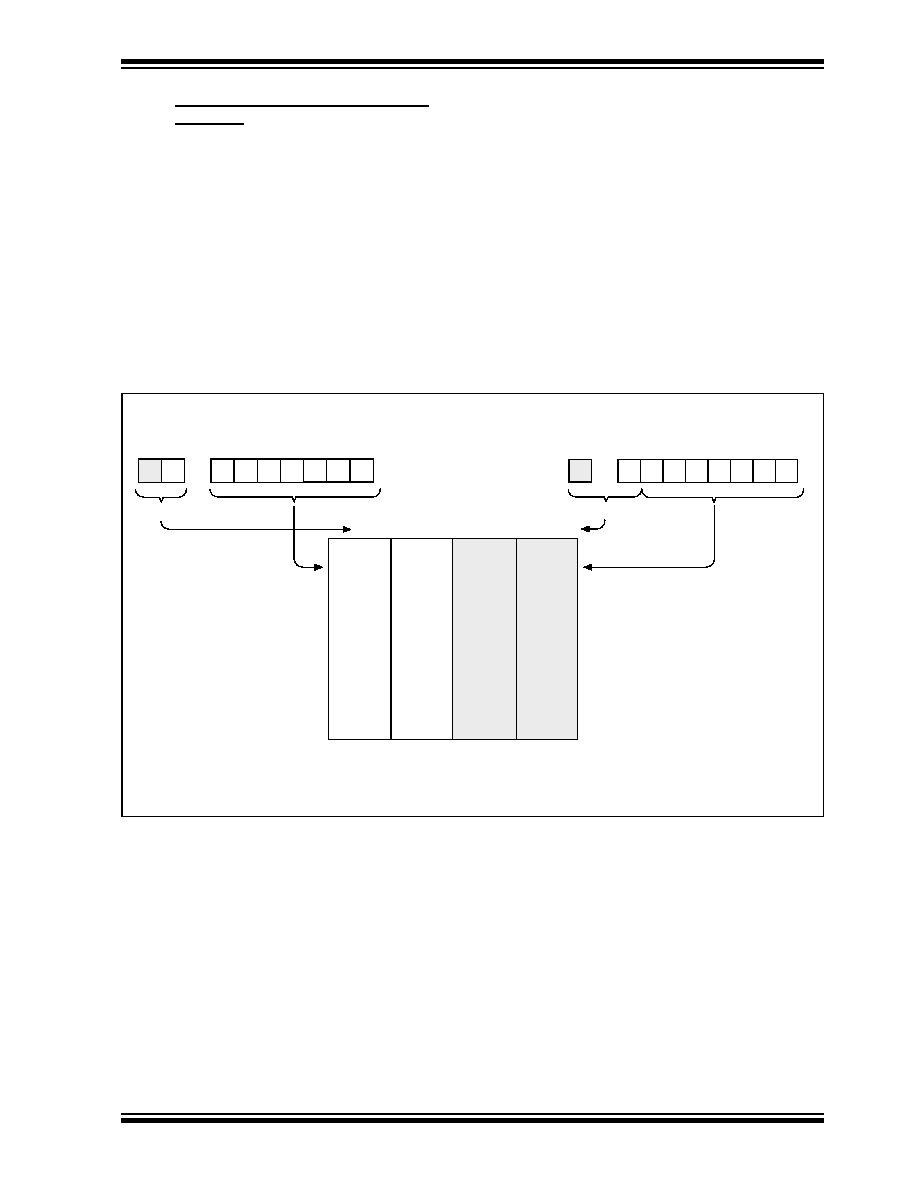- 您现在的位置:买卖IC网 > Sheet目录3886 > PIC16LCE625T-04E/SS (Microchip Technology)IC MCU CMOS 2K OTP W/EEPRM20SSOP

1999 Microchip Technology Inc.
DS40182C-page 21
PIC16CE62X
4.4
Indirect Addressing, INDF and FSR
Registers
The INDF register is not a physical register. Addressing
the INDF register will cause indirect addressing.
Indirect addressing is possible by using the INDF reg-
ister. Any instruction using the INDF register actually
accesses data pointed to by the File Select Register
(FSR). Reading INDF itself indirectly will produce 00h.
Writing to the INDF register indirectly results in a
no-operation (although status bits may be affected). An
effective 9-bit address is obtained by concatenating the
8-bit FSR register and the IRP bit (STATUS<7>), as
shown in Figure 4-7. However, IRP is not used in the
PIC16CE62X.
A simple program to clear RAM location 20h-2Fh using
indirect addressing is shown in Example 4-1.
EXAMPLE 4-1:
INDIRECT ADDRESSING
movlw
0x20
;initialize pointer
movwf
FSR
;to RAM
NEXT
clrf
INDF
;clear INDF register
incf
FSR
;inc pointer
btfss
FSR,4
;all done?
goto
NEXT
;no clear next
;yes continue
CONTINUE:
FIGURE 4-7:
DIRECT/INDIRECT ADDRESSING PIC16CE62X
For memory map detail see Figure 4-4 and Figure 4-5.
Note 1: The RP1 and IRP bits are reserved; always maintain these bits clear.
Data
Memory
Indirect Addressing
Direct Addressing
bank select
location select
RP1
RP0(1)
6
0
from opcode
IRP(1)
FSR Register
7
0
bank select
location select
00
01
10
11
180h
1FFh
00h
7Fh
Bank 0
Bank 1
Bank 2
Bank 3
not used
发布紧急采购,3分钟左右您将得到回复。
相关PDF资料
1-84981-2
CONN FFC 12POS 1.00MM R/A SMD
PIC16LCE625T-04E/SO
IC MCU CMOS 2K OTP W/EEPRM18SOIC
1-84534-8
CONN FFC 18POS 1.25MM VERT
PIC18C452T-E/PT
IC MCU OTP 16KX16 A/D 44TQFP
PIC18C242T-E/SO
IC MCU OTP 8KX16 A/D 28SOIC
PIC16LCE624T-04I/SO
IC MCU CMOS 1K OTP W/EEPRM18SOIC
PIC16F688-I/ML
IC PIC MCU FLASH 4KX14 16QFN
PIC16LCE624T-04E/SS
IC MCU CMOS 1K OTP W/EEPRM20SSOP
相关代理商/技术参数
PIC16LCE625T-04I/SO
功能描述:8位微控制器 -MCU 3.5KB 128 RAM 13 I/O RoHS:否 制造商:Silicon Labs 核心:8051 处理器系列:C8051F39x 数据总线宽度:8 bit 最大时钟频率:50 MHz 程序存储器大小:16 KB 数据 RAM 大小:1 KB 片上 ADC:Yes 工作电源电压:1.8 V to 3.6 V 工作温度范围:- 40 C to + 105 C 封装 / 箱体:QFN-20 安装风格:SMD/SMT
PIC16LCE625T-04I/SS
功能描述:8位微控制器 -MCU 3.5KB 128 RAM 13 I/O RoHS:否 制造商:Silicon Labs 核心:8051 处理器系列:C8051F39x 数据总线宽度:8 bit 最大时钟频率:50 MHz 程序存储器大小:16 KB 数据 RAM 大小:1 KB 片上 ADC:Yes 工作电源电压:1.8 V to 3.6 V 工作温度范围:- 40 C to + 105 C 封装 / 箱体:QFN-20 安装风格:SMD/SMT
PIC16LF1454-E/ML
制造商:Microchip Technology Inc 功能描述:7 KB FLASH, 512 BYTES RAM, 48 MHZ INT. OSC, 12 I/0, ENHANCED - Rail/Tube 制造商:Microchip Technology Inc 功能描述:IC MCU 8BIT 7KB FLASH 16QFN 制造商:Microchip Technology Inc 功能描述:8-bit Microcontrollers - MCU 7KB Flsh 512b RAM 48MHz Int Osc 12 I/0
PIC16LF1454-E/P
制造商:Microchip Technology Inc 功能描述:7 KB FLASH, 512 BYTES RAM, 48 MHZ INT. OSC, 12 I/0, ENHANCED - Rail/Tube 制造商:Microchip Technology Inc 功能描述:IC MCU 8BIT 7KB FLASH 14PDIP
PIC16LF1454-E/SL
制造商:Microchip Technology Inc 功能描述:7 KB FLASH, 512 BYTES RAM, 48 MHZ INT. OSC, 12 I/0, ENHANCED - Rail/Tube 制造商:Microchip Technology Inc 功能描述:7 KB Flash, 512 bytes RAM, 48 MHz Int. Osc, 12 I/0, Enhanced Mid Range Core, USB 2.0, NanoWatt XLP
PIC16LF1454-E/ST
制造商:Microchip Technology Inc 功能描述:7 KB FLASH, 512 BYTES RAM, 48 MHZ INT. OSC, 12 I/0, ENHANCED - Rail/Tube 制造商:Microchip Technology Inc 功能描述:IC MCU 8BIT 7KB FLASH 14TSSOP
PIC16LF1454-I/ML
功能描述:8位微控制器 -MCU 7 KB Flash 512 bytes RAM 48 MHz Int Osc
RoHS:否 制造商:Silicon Labs 核心:8051 处理器系列:C8051F39x 数据总线宽度:8 bit 最大时钟频率:50 MHz 程序存储器大小:16 KB 数据 RAM 大小:1 KB 片上 ADC:Yes 工作电源电压:1.8 V to 3.6 V 工作温度范围:- 40 C to + 105 C 封装 / 箱体:QFN-20 安装风格:SMD/SMT
PIC16LF1454-I/P
功能描述:8位微控制器 -MCU 7 KB Flash 512 bytes RAM 48 MHz Int Osc
RoHS:否 制造商:Silicon Labs 核心:8051 处理器系列:C8051F39x 数据总线宽度:8 bit 最大时钟频率:50 MHz 程序存储器大小:16 KB 数据 RAM 大小:1 KB 片上 ADC:Yes 工作电源电压:1.8 V to 3.6 V 工作温度范围:- 40 C to + 105 C 封装 / 箱体:QFN-20 安装风格:SMD/SMT